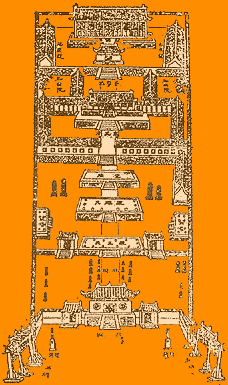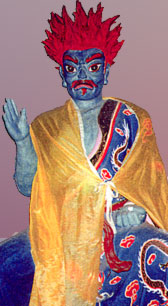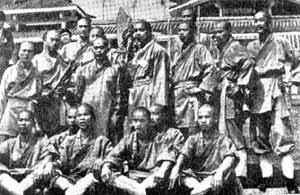Shaolin
Kung Fu OnLine Library
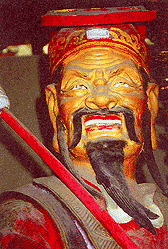
|

6.
The six rule is the knowledge of arm and leg work during a fight. The special point with Shaolin combat arts is fist work. The pugilistic methods are such that each punch must pierce the enemy and cut him into pieces. The arm should bend without bending and unbend without unbending so that the enemy could not follow your movements and could never get sight of your punch. Your arms should separate your thorax with a speed of a lightning. Activity and training of sinews determine the force of arms. The punch must be a surprise, so the enemy could not avoid it. The arm must make an accurate cut, obediently flying up and readily, if necessary, going down. Notwithstanding how your body is twisted and your hands are bound by the enemy, there is always a chance to free yourself, like a swallow has always a chance to find water springs. If in a close combat one of the hand is pinned down or both hands are neutralized, you can punch with a stone elbow. Your punch can be directed into the enemy's pudenda from below. Leg movements are more mysterious. There are seven leg works: "qi" - uprising,
"fan" - overturning, "lo" - tumbling, "zhin" - advance, "ti" - kick, "qai" - kick,
"zhuan" - kick. All the five natural elements unite into one "chi", feet act in unison striking from the front and from the rear, so it is impossible to approach you. Step by step and no any sound is heard except sounds of punches of infuriated soles touching the ground after strikes. The legs are like ferocious tigers or dragons in the sky.
7.
The seventh rule demands simultaneous advance of arms and legs, because during the fight they act together and depend on each other. If you furiously use only your arms, the result may be only satisfactory; the reason is: when you advance, your feet, arms and torso should act in complete agreement.
One should aim at achieving the following qualities: mind, body obedience, manhood, speed and fury. During an actual fight those five qualities will bring you miraculous results. Mental work -
"gong" means that during a fight one must more depend on one's mind. Body obedience -
"shun" means that one must train his body for a long time to make it natural one. Manliness -"yong" means that one should work out bold plans and boldly realize them. Speed - "ji" implicates that during the execution of methods of
hand-to- hand fighting one must act fast like a lightning. Fury -
"hen" is required only at the moment of your attacks.
You should keep a vigilant watch over enemy's stances and positions and clearly understand them. You must easily find his weak points. You should not rashly start fighting and deliver blows.
8.
The eighth precept one should know about combat arts is all-round defense, its distinct manifestations and timely pursuit. If a man keeps in harmony those rule in his actions, he will become invincible. The rule of cover -
"ting" consist in the necessity of permanent protection in the front, from the behind, from the left and from the right. Besides, one must not forget that the enemy can strike from above and from below. The rule of opening - "kai" consist in the necessity of opening your weak or strong points depending on the situation on the left or on the right and in the necessity of delivering and receiving blows with the support of sinew force. Both fist and palm must be formed during a spurt.
The rule of distinct manifestation - "zhe" is used for the work of arms, body, head and heart. At the moment of an action there should be a clear and efficient manifestation. If you act, you must be as fierce as a tiger, and if you manifest a sentiment, it must be a frightening fury. Your shout should frighten your enemy. You should be able to win without a fight, only with your loud laughter. This rule consisting of few hieroglyphs is more precious than gold. The rule of pursuit - "zhui" consists in the following. You should use any opportunity to pursuit your enemy and should not give him a chance to collect himself. As soon as steps become faster, you should use this opportunity to rush to the enemy. If at that moment you act like lightning and thunder, you can take anyone by surprise.
9.
The ninth rule which one should know about combat arts is as follows. Three human elements -
eyes, ears and heart intelligence must be in
harmony. You should have attentive and active eyes and follow any enemy's manipulations all the time. You must prick your ears to sense movements and rest. You should have keen ears to hear voices of tigers and snow leopards from the eight sides of the Universe. The eyes look, the ears listen and they transmit the received information to the heart. If the heart is bright and eyes are alert, you will not commit mistakes.
10.
The tenth rule for those who practice in combat arts is as follows. Use your sinews, because "shen", the ability to use spiritual sources, allows to achieve a great success. Sinews are chiefs of bones. If sinews tremble, "chi" energy is wasted. Furthermore, sinews are transmitters of information of three senses (vision, hearing and
mind). If you are in possession of them, it is a great success.
*** |
Shaolin
Kung Fu OnLine Library

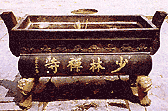

|
Shaolin
Kung Fu OnLine Library


|
Those are the
Ten
Basic Precepts of Combat Arts. To achieve them, one must work a lot. The most valuable quality for mastery of combat arms is persistence. One must persistently engage in pugilistic arms and weapon use. In winter frost and snow are not hindrances to it. In summer one should train himself notwithstanding hot weather, when you are running wet with sweat. Even if you have a headache, you should train your body to make it firm and strong. Do not stop, even for a moment, your persistent efforts to preserve your life and destiny.
One should remember that only the noble men of high morals may be taught the true combat art. On no account a bad man who does not follow true "dao" (the way) should be taught.

|
| Secrets |
| of |
| Southern
Shaolin |
 |
| Lam
Sai Wing |
| (1860-1943) |
|
"Since my young years till now, for
50 years, I have been learning from Masters.
I am happy that I have earned the love of my tutors who passed on me the Shaolin Mastery…"
|
|














